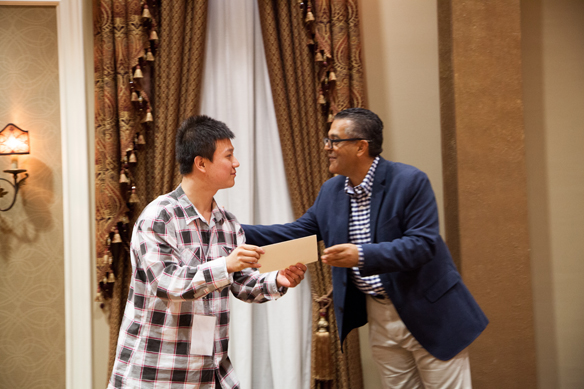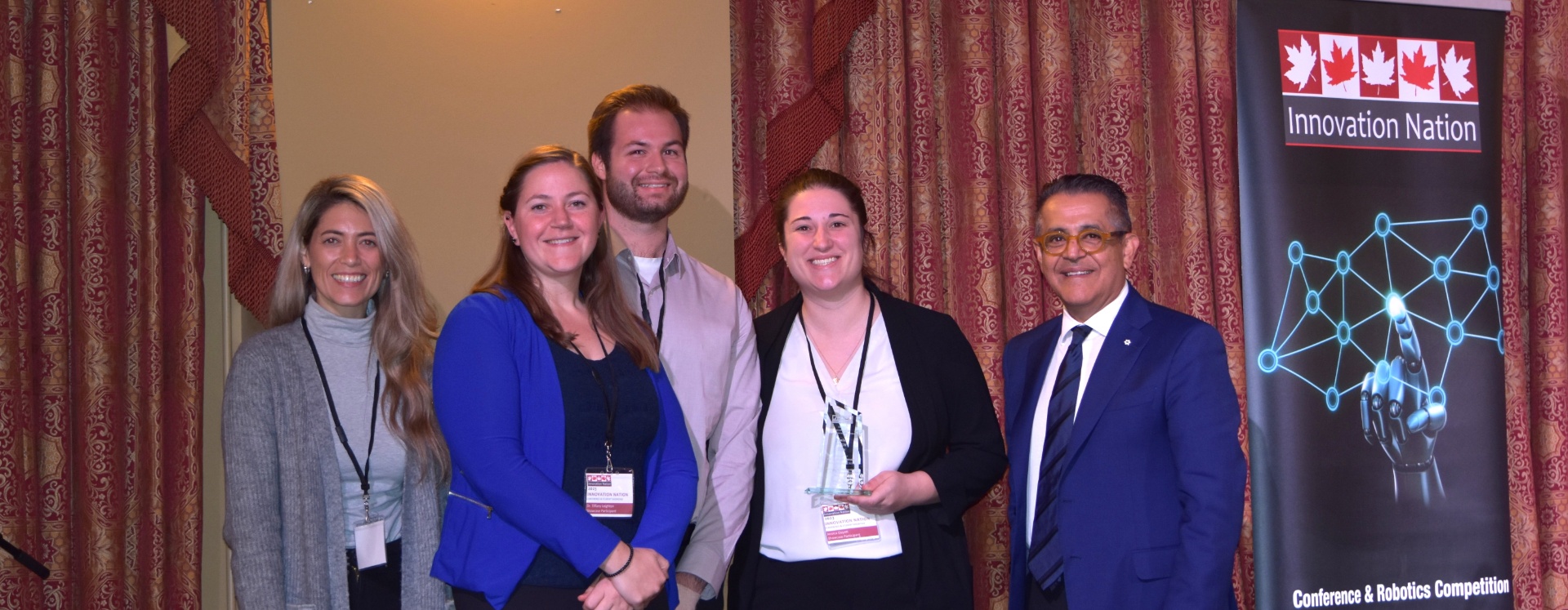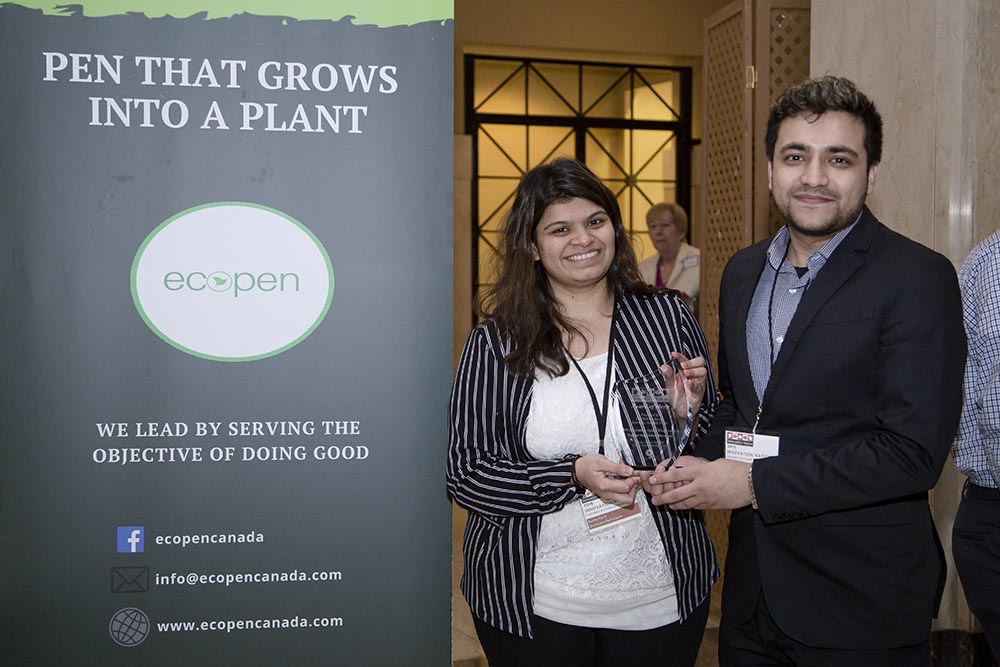Past Winners

Congratulations to all former winners. Please view a list of competitors and finalists.
Innovation Nation now features a Student Innovation Showcase.
Best Start-up
Nearview
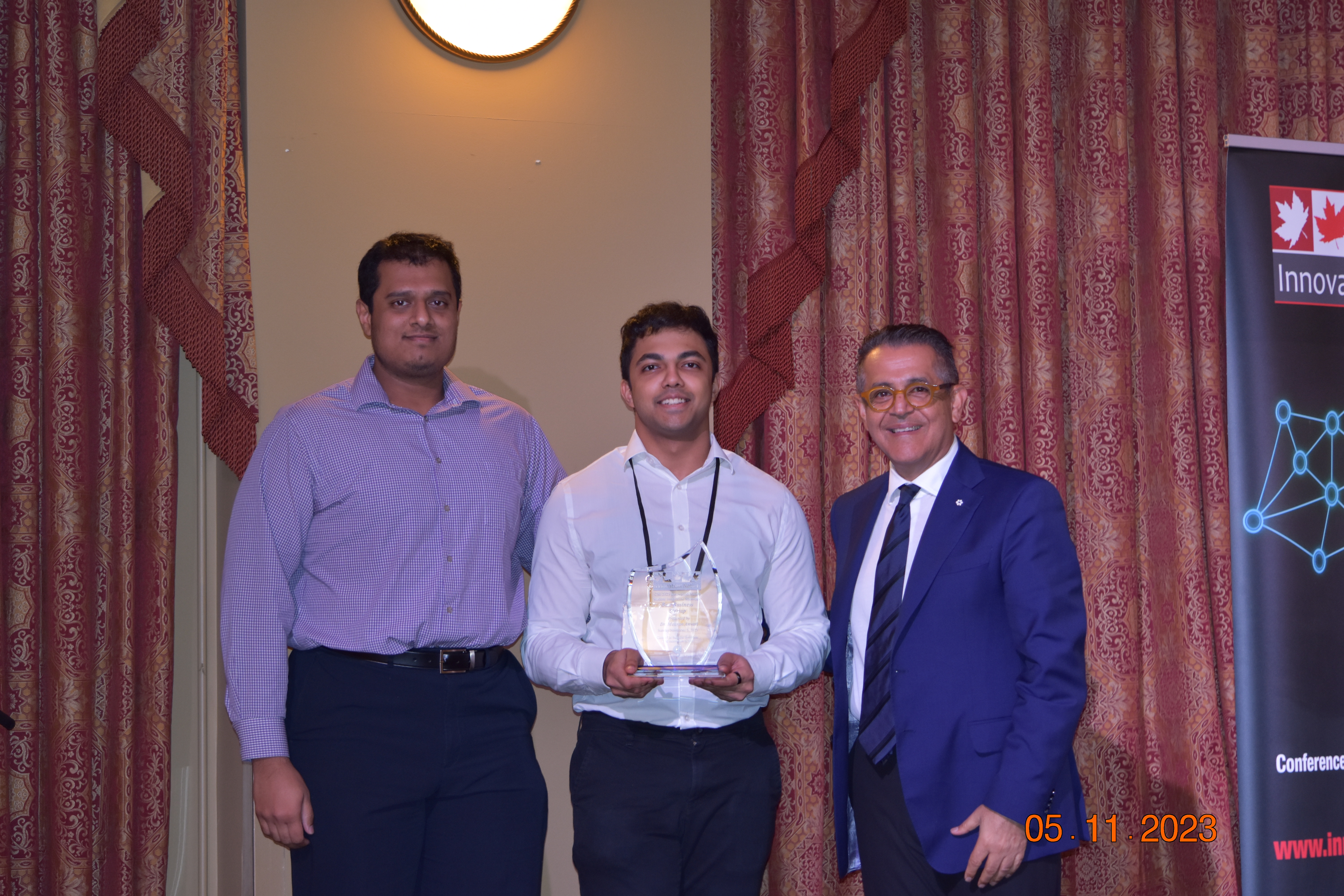
Best in Show
Revolutionizing Prosthetics
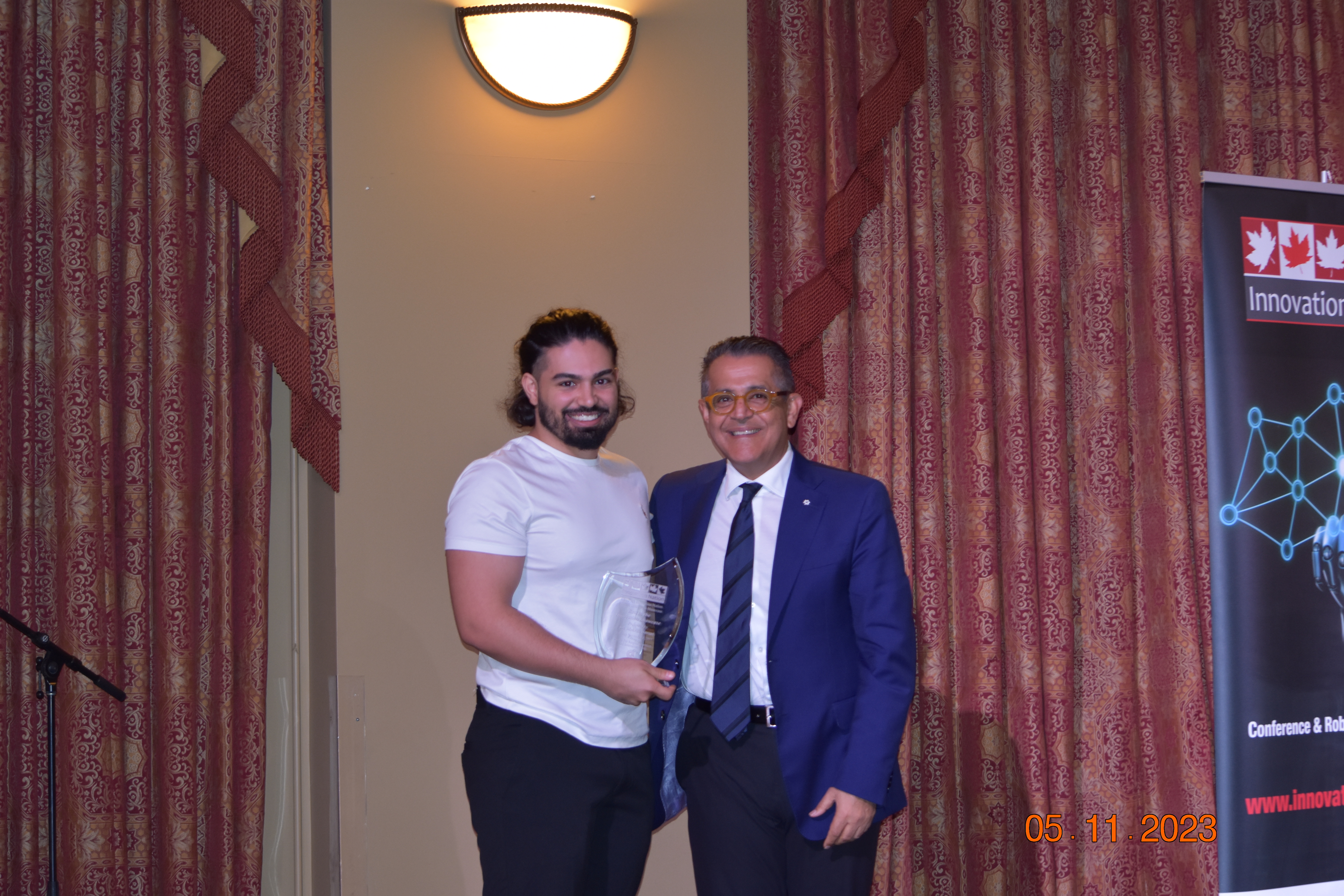
STEM Stars
Researching Tobacco Plants as Bioreactors
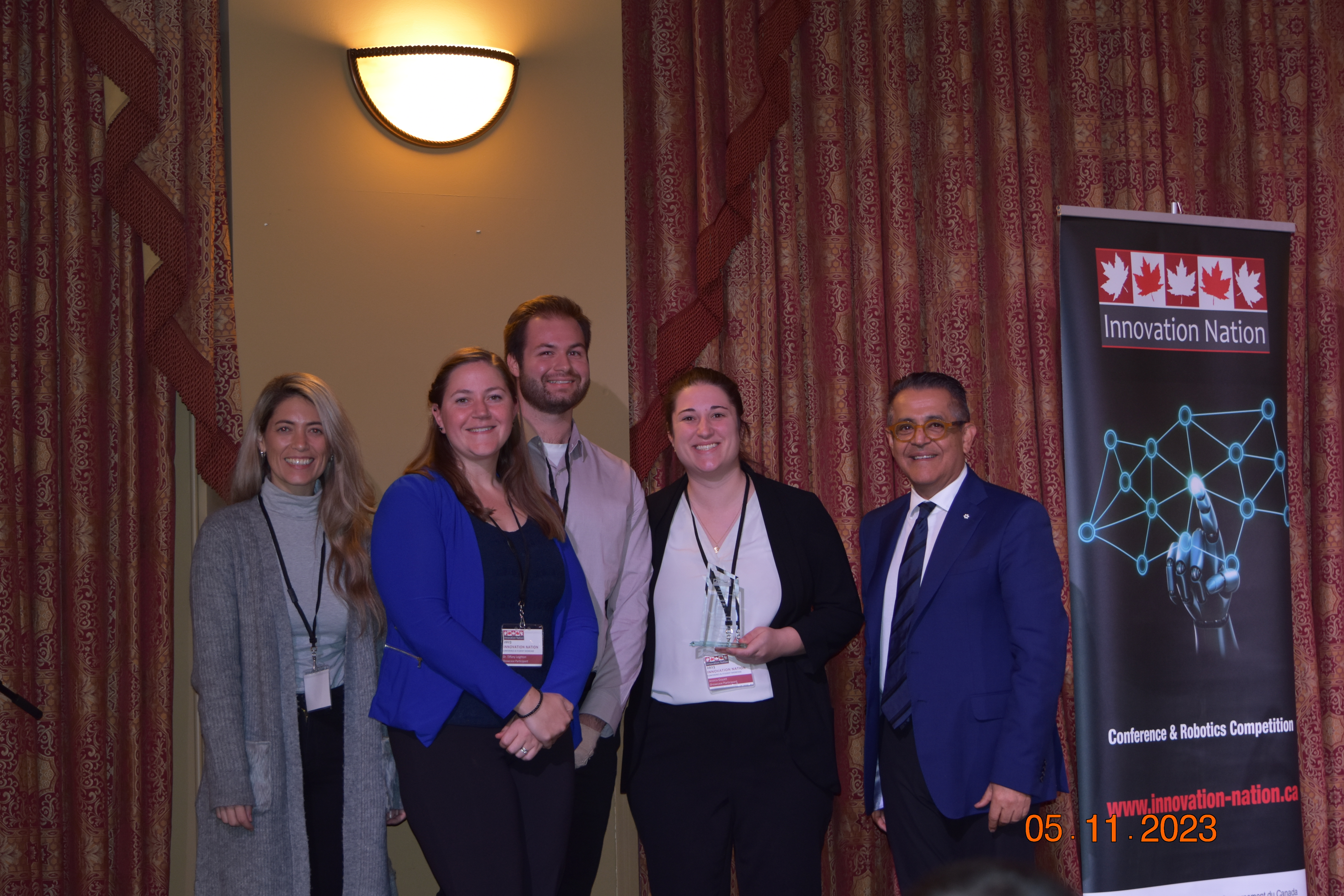
Award of Merit
Green Energy
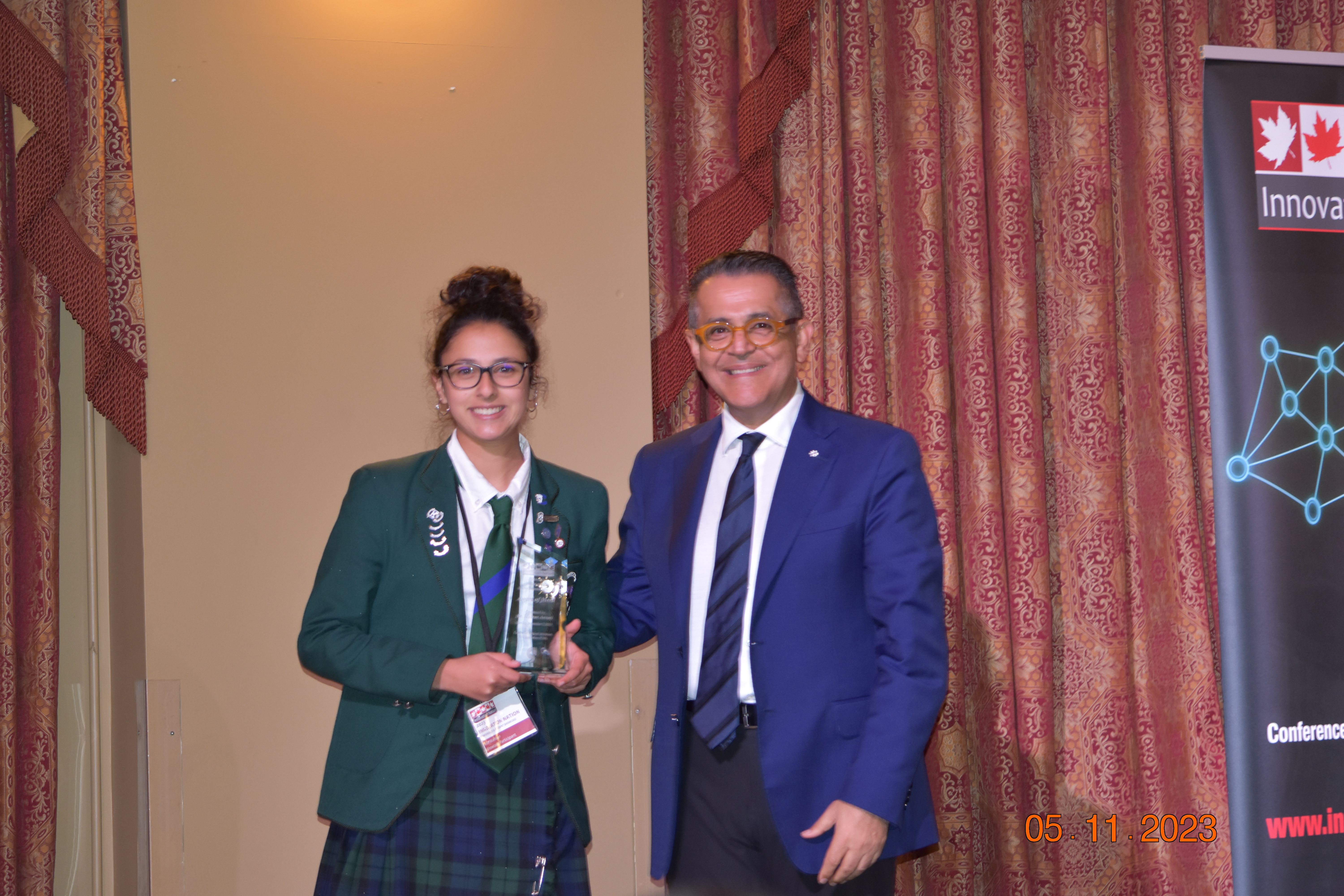
Grand Prize
Ahmed Ibrahim - Prostatic Hand
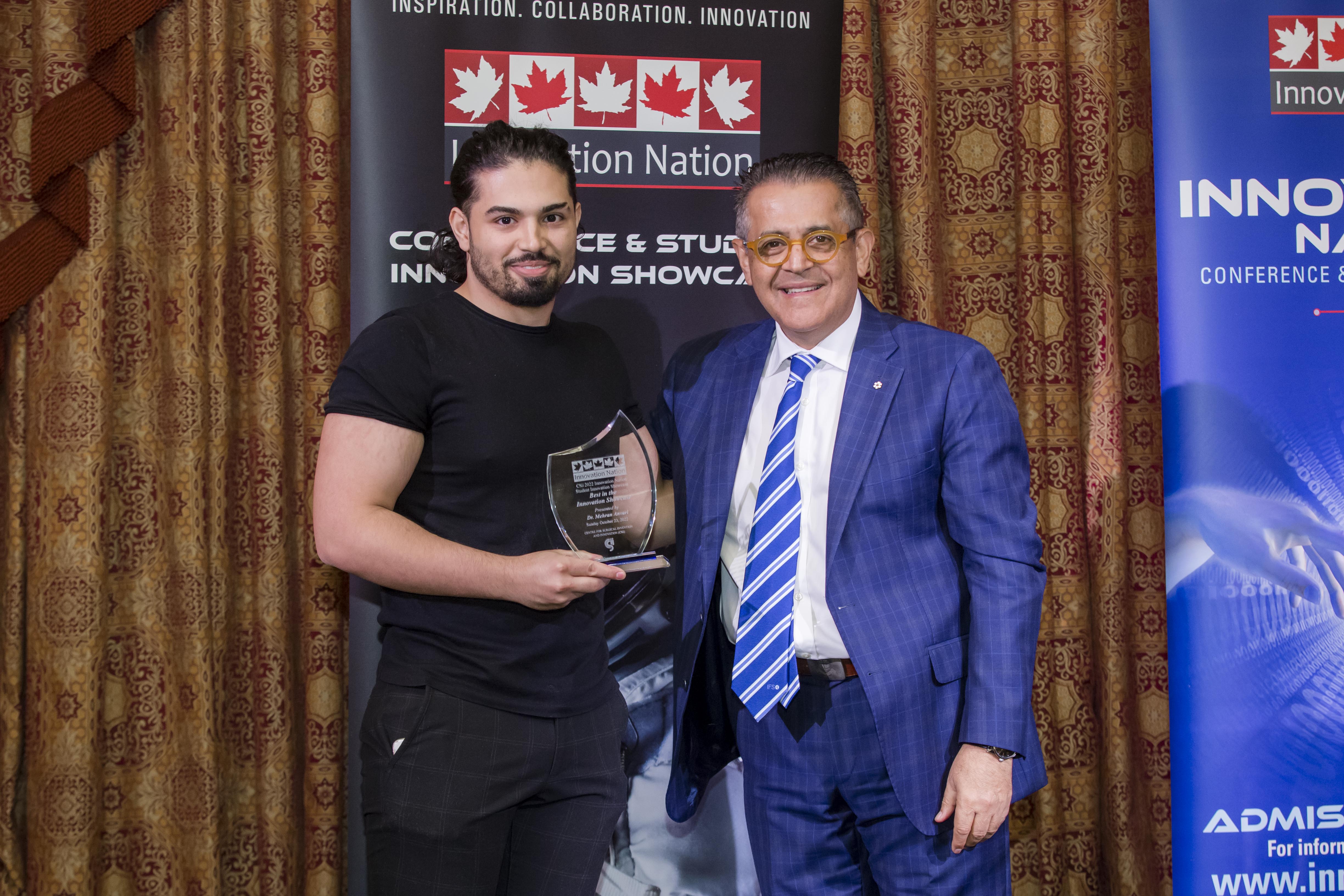
Future STEM Star
Isaiah Sienna - The Effects of Plastic Contamination in Plastic Water Bottles
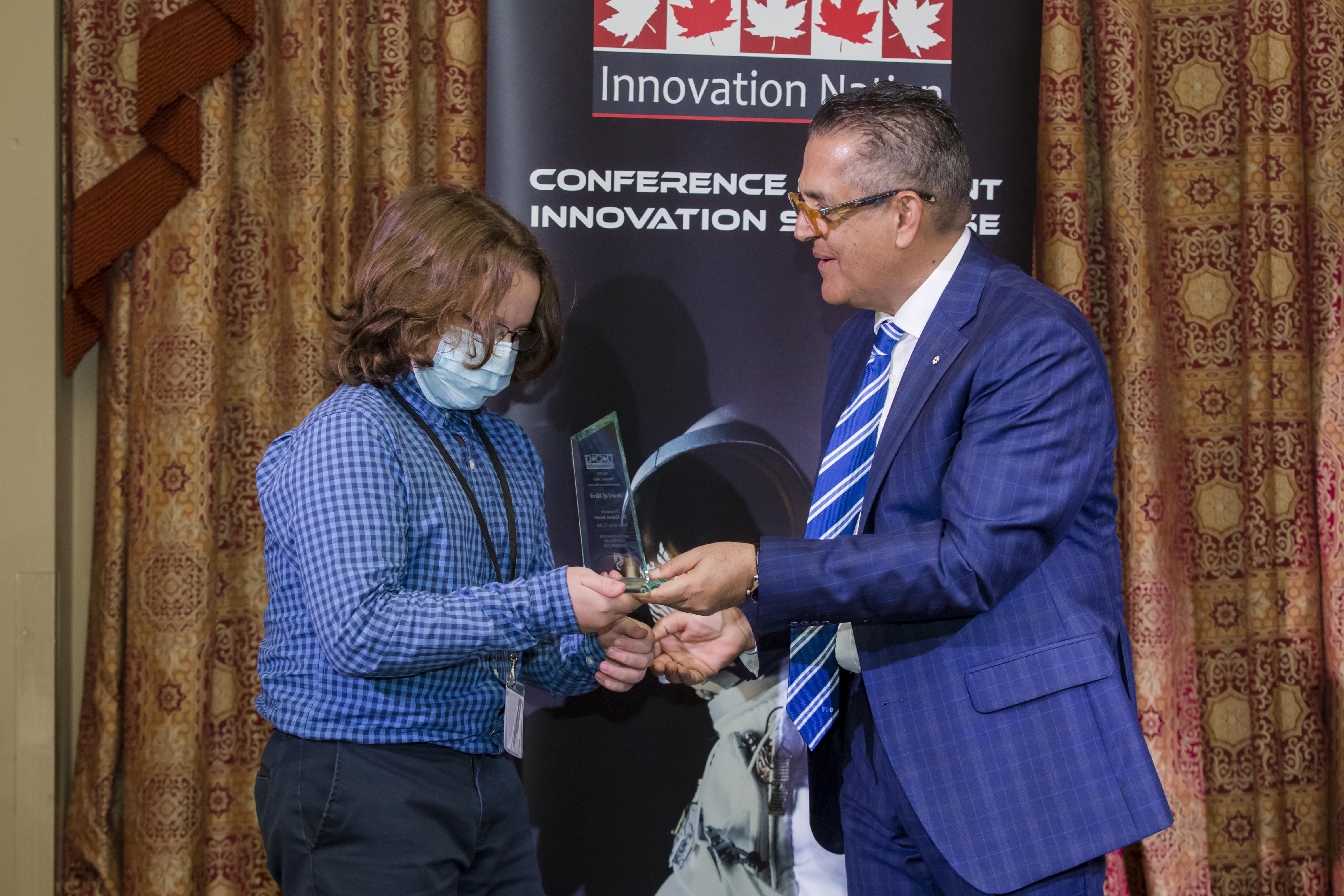
Junior STEM Star
Kadhir Ponnambalam - Tardigrades
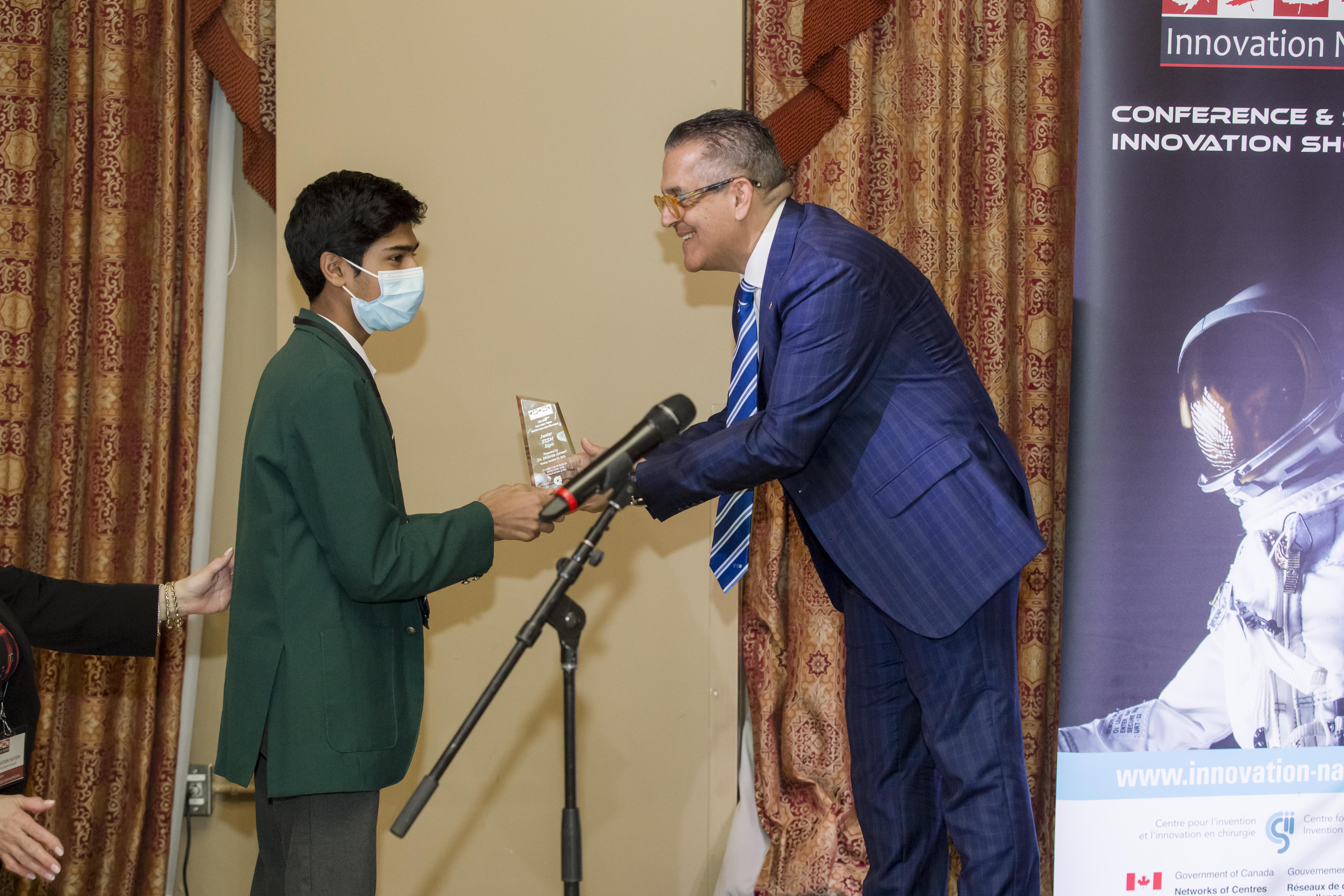
2019 ORDER OF MERIT
McMaster University
- Eco-Pen
- AliAwais Amin
- Rucha Kolte
2019 AWARD OF EXCELLENCE
McMaster University , B; Tech Program,
Project Portable Electric Wheel Chair Drive
- Vito Naso
- Milan Izzo
- Jon Breton
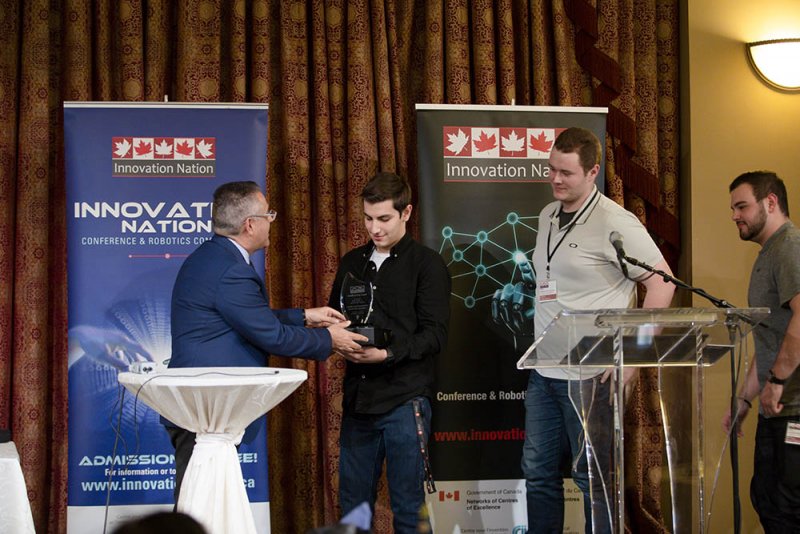
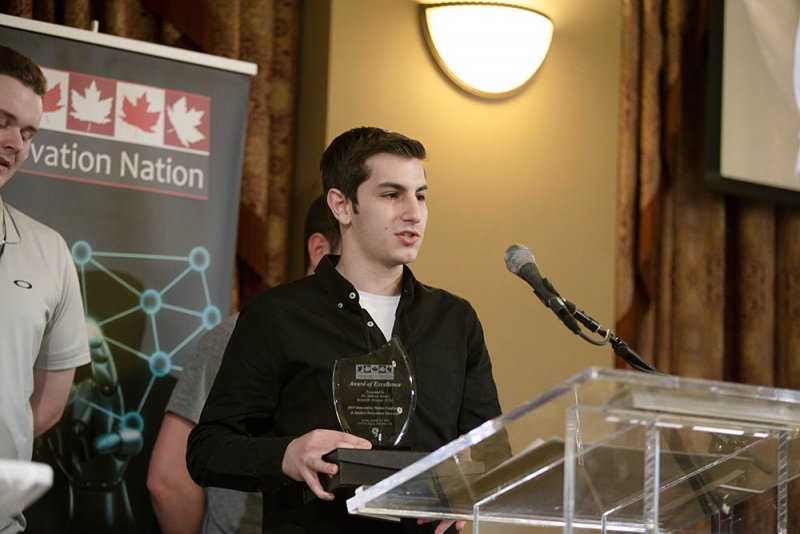
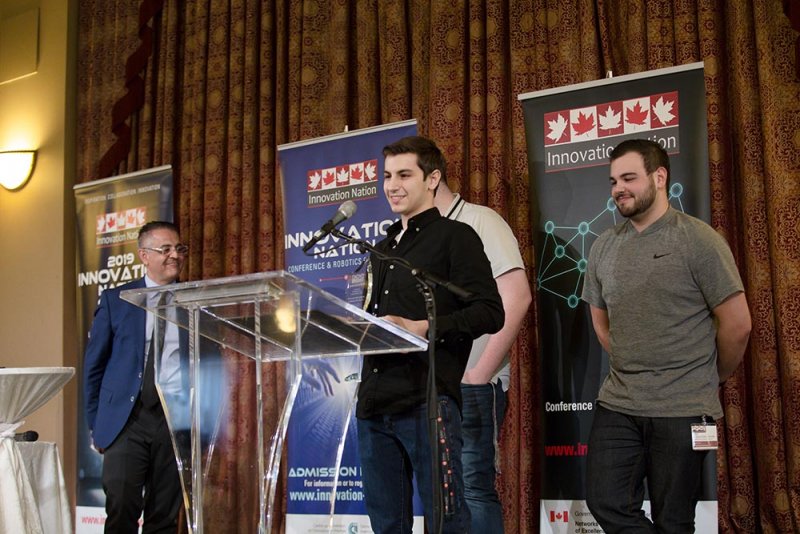
First Place Winners
Team: X-Drive
School: McMaster University, Hamilton, ON
Robot: Manual to Power Wheel Chair Conversion Kit
Description of Robot:
Our project solution is a smart phone controlled power conversion kit that fits the majority of manual wheelchairs. The kit is be easily removable, has a simple initial setup and meets the minimum speed of a walking pace. By being app-controlled, the system does away with the conventional joystick. This adds convenience to the user as they can use their own mobile device or tablet as well as complexity to the project. The product will also not affect the mobility of the manual wheelchair by using a compact design.
3 Key Elements:
Android Controlled Via Blue Tooth – Joy Stick App Developed By Badri
- Acts as a joystick controller to move the wheelchair
- Based on the finger gesture, the program returns direction, x-coordinate, y-coordinate, and the displacement from the center
- Bitmap, openGL, and canvas were used to design the joystick
- A mathematical algorithm was written to ensure the joystick cursor stays within the restricted area
Easily adaptable to many wheelchairs
- The X-Drive is attached to a bar which slides onto the back of the chair. An industry expert informed us the the “wheelie” bar where the bar slides on is a common standard
Overall the best quality of the X-Drive is its ability to allow a manual wheel chair use to maintain the advantages of a manual wheel chair (ease of transport, weight, low cost) while combining the advantages of powered wheel chair (low body strain, ease of use). It does while keeping the cost low and looking cool.
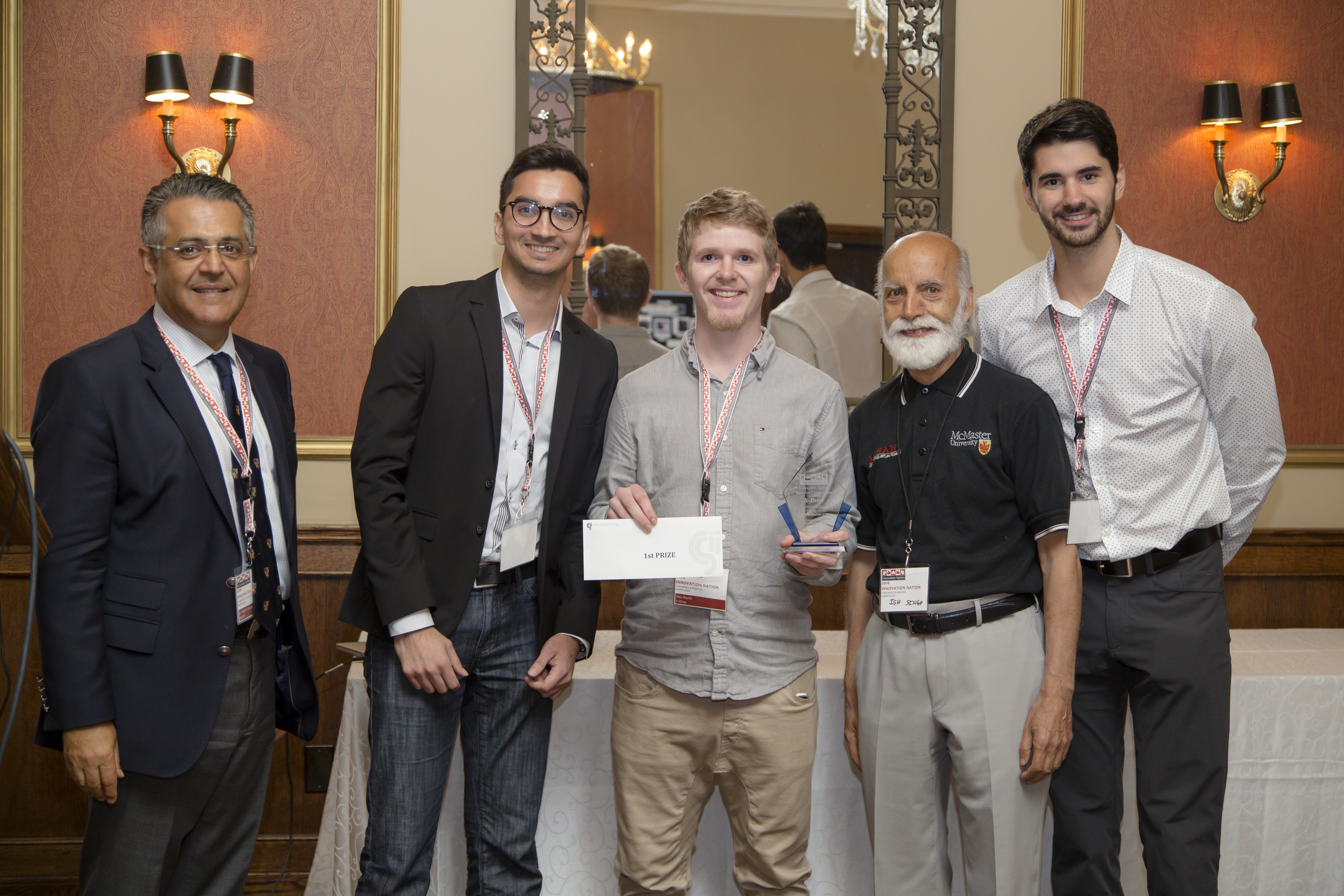
Second Place Winners
Team: Brain Computer Interface Evolutionary New Prosthetics
School: Glendale Secondary School, Hamilton, ON
Robot: Brain Computer Interface Evolutionary New Prosthetics
Description of Robot:
Reads neuron patterns and determines the thought of the user.
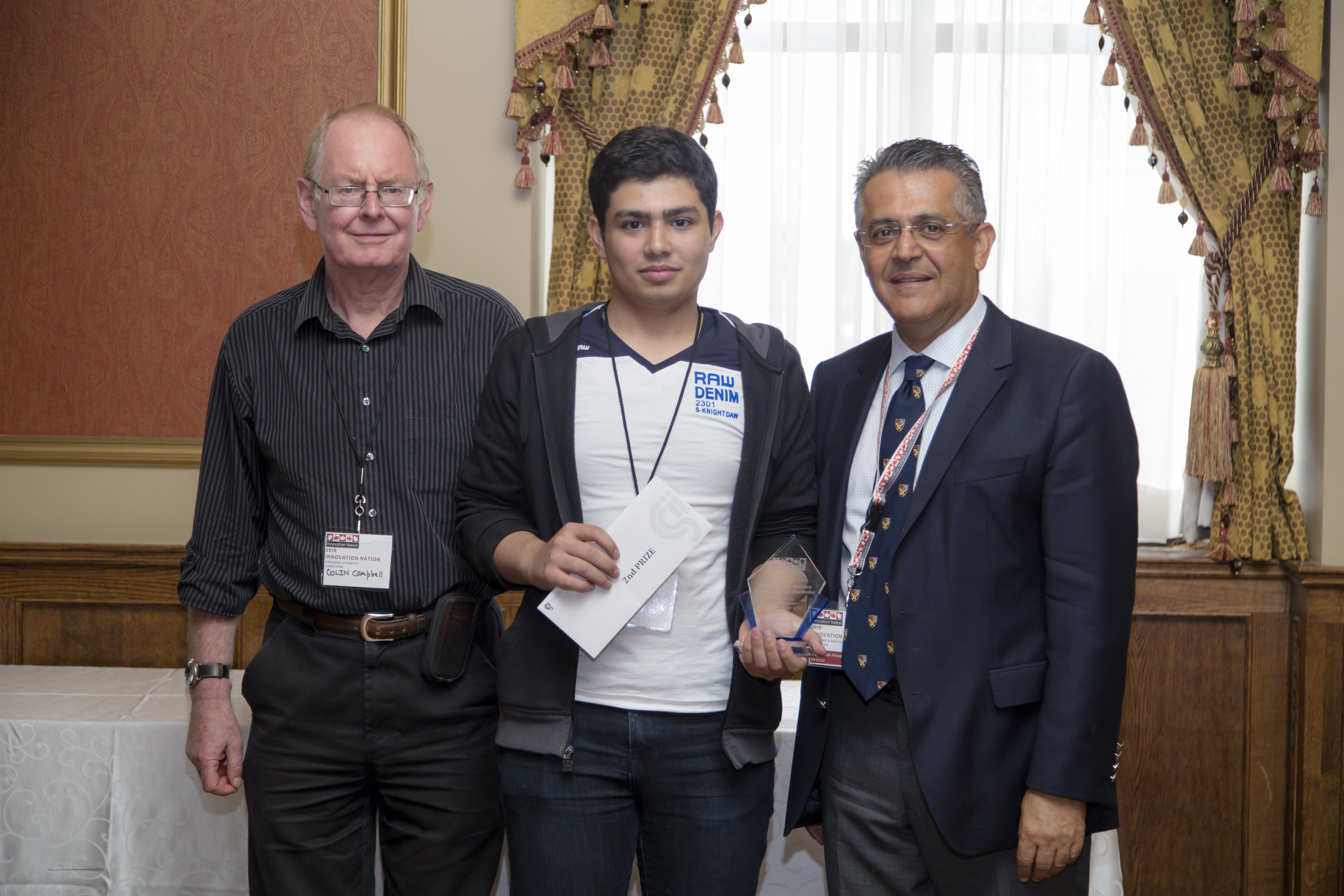
Third Place Winners
Team: KaST Robotics
School: John Polanyi Collegiate, Toronto, ON
Robot: Formulator 3D Printer
Description of Robot
The Formulator 3D printer was developed by expanding the frame, adding a larger base, and a second extruder, of the Makeblock Constructor. Our printer, which cost approximately $1000 to make, has comparable quality in printing as a professional, $25000 printer, and also much more expansion capability. Due to the modular design, and open source Arduino platform, we are able to very cheaply upgrade any part of our printer.
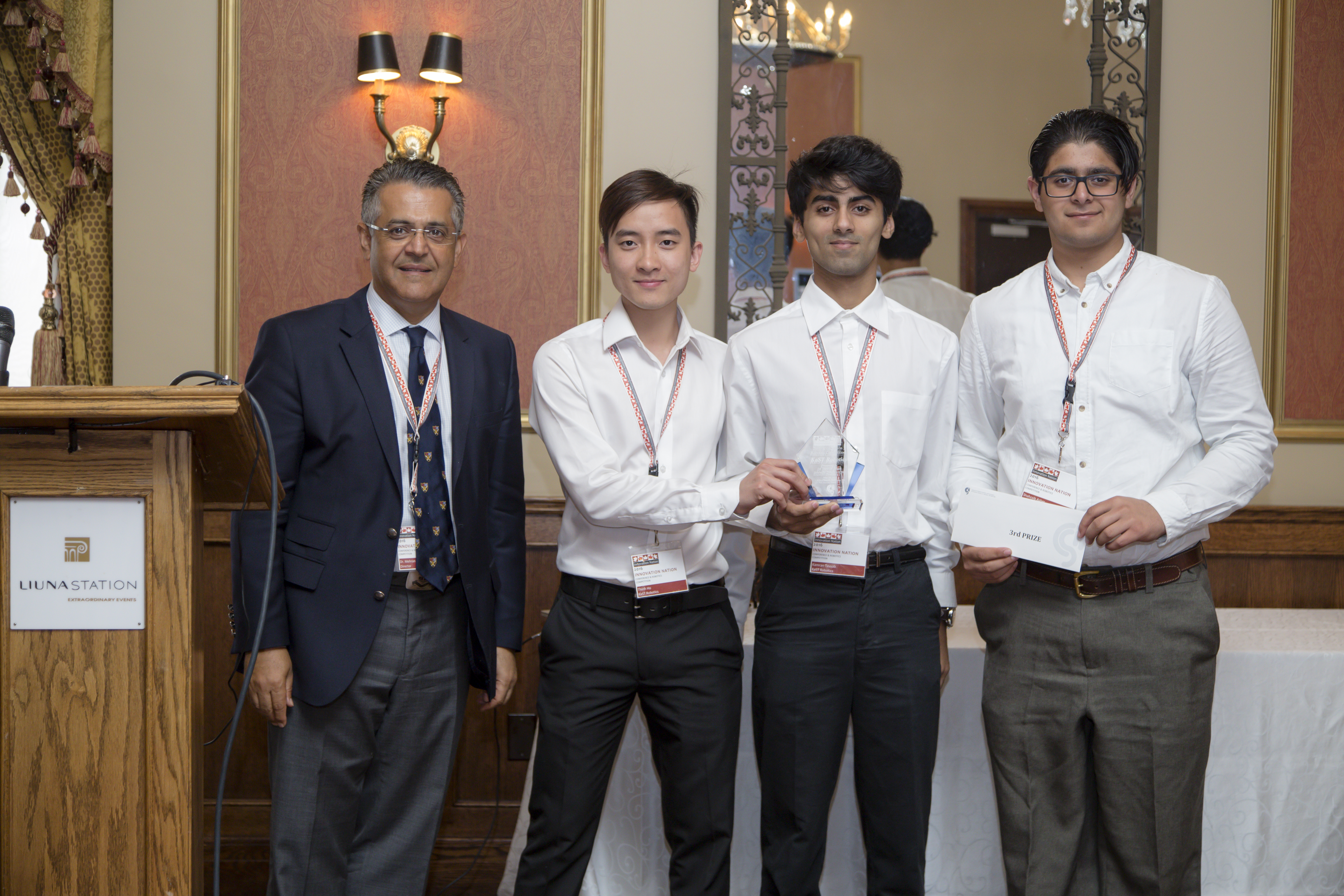
First Place Winners
Team: BeaverworX
School: Our Lady of Lourdes Catholic High School, Guelph, ON
Robot: Personal Mobile Assistive Device
Description of Robot
The OmniChair is 44” in diameter and 42” tall. It has been designed to assist the disabled in gaining greater degrees of mobility than those with standard electric wheelchairs. The functionality of the OmniChair is to allow the user to be able to move near the same range of motion as a non-disabled person would be able to.
3 Key Elements:
Designed for the FIRST competition, and revised to be used in a real world application. Holonomic drive and omnidirectional wheels allow for flexibility when in motion. Control system efficiently does calculations and motor control outputs, and with the added safety features, it gives the user a smooth and safe ride.
With six wheels that have perpendicular rollers, our robot is capable of moving in any direction and rotating at the same time. Each wheel is on a separate motor, controlled by six electronic speed controllers.
The OmniChair combines the Arduino and the Raspberry Pie in order to create a compact, responsive control system. The Raspy Pi, being a miniature computer, continuously runs a Python script to capture the input from the controllers, and do inverse kinematics calculations to translate controller input into individual motor powers. Then, using the reliable method of serial communication, the motor values are sent to the Arduino, which in turn drives the motors with their respective powers.
The OmniChair’s SeatLok is a reliable system to ensure that if the Omni chair come to an abrupt stop, or take part in a collision the user will remain in the omni chair. A parking brake allows the user to safely park, hands free. Acceleration control gives the user a smooth riding experience, slowly increasing speed limits risk of injury. The Anti-lock Braking System allows for a safe and effective emergency stopping measure should the need arise on slippery or uncertain terrain. SpeedChange allows the user to easily modify their top speed.
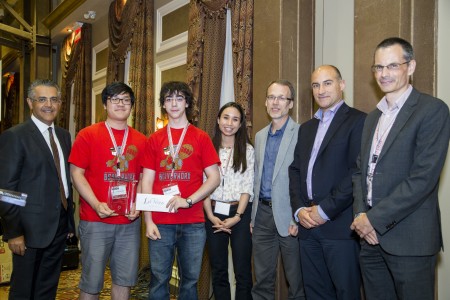
Second Place Winners
Team: Roboticus Asimovus
School: Ecole Secondaire Jeunes sans Frontieres, Brampton, ON
Robot: Automatic Seed Planter
Description of Robot:
Our S.I.F. was born from an Earthway brand seed planting machine. We removed the front wheel and adapted a two wheeled cross member in order to provide drive and directionality. Seed dispensing is controlled by a motor that is programmed to dispense seeds in relation to the speed that the planter travels, thereby maintaining proper plant spacing. Forward movement is controlled by an Arduino microcontroller and servo motors. Directionality is provided by the G.P.S. component of the system. The entire system is solar rechargeable (trickle charge while in use) via the two solar panels mounted on top of the hopper. At the end of the day, the farmer can return it to a central charging station and remove the batteries for freshly recharged ones. This allows for use between many farmers of the same community. Our 3-D printer was used to fabricate parts necessary for the conversion of the seed planter (bushings, seed disc driver).
3 Key Elements:
- Up-scaleable: the S.I.F. can be up-scaled with larger motors, larger hopper or watering tank. This would provide for longer planting cycles, improved ruggedness and an initial watering of the planted seeds.
- Simple to program via Arduino microcontroller: an icon based, user interface would provide for simplicity in programming, regardless of farmer language
- Commonly available parts: the Beta version would be fitted with common bicycle wheels. Bicycles in underprivileged countries are more common than manufactured parts. Remote areas would greater access to spare parts which are easily accessible and replaceable.
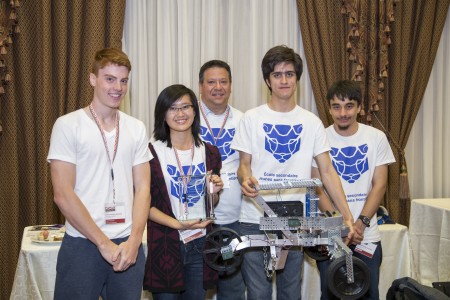
Third Place Winners
Team: Westmount Robotics
School: Westmount Secondary School, Hamilton, ON
Robot: Automatic Pill Dispenser
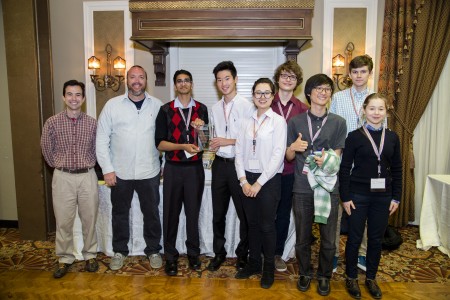
First Place Platinum Winners
Platinum Winner: Robotics for Space Exploration (RSX)
“Martian Exploration Rover”
Team Name:
Karim Koreitem, Rahul Goel, Kramay Patel, Askar Kazbekov, Aakash Goel, Philip Lee, Masha Itkina, Kiah Bransch, He He, Bryan Tarras, Kevin Olsen, Ekansh Sharma
Description of Robot:
Origin is a tele-operated rover designed for planetary exploration – specifically, Mars. It is controlled from a distant base station, and is equipped with various mechanical components, sensors, and electronics. It is designed to rove and complete a variety of tasks in challenging environments where human involvement is unsafe or impossible.
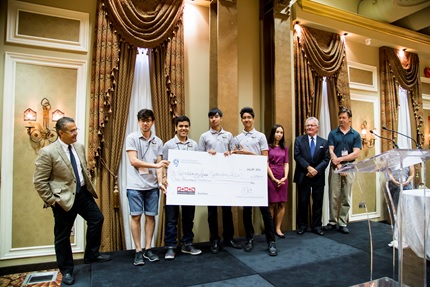
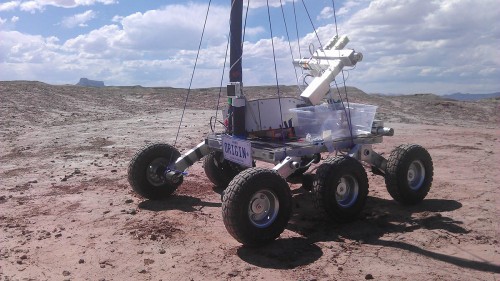
Second Place Winners
Team Name: BeaverworX
“Polar Vortex“
Group Members
Tom Vuong, Reli Desosa, Mayur Saxena, Billy Parmenter
Description of Robot:
The robot, Polar Vortex, is a competitive game playing robot designed for the 2014 FIRST competition. FIRST imposes limits on the size and shape of the robots. Polar Vortex is 44” in its greatest diameter and 42” tall. “AERIAL ASSIST is played by two competing Alliances of three robots each on a flat 25’ x 54’ foot field, straddled by a truss suspended just over five feet above the floor. The objective is to score as many balls in goals as possible during a two (2)-minute and 30-second match. The more Alliances score their ball in their goals, and the more they work together to do it, the more points their Alliance receives.” (US FIRST) To achieve this Polar Vortex is capable of a great deal of control of the ball. The ball can be retrieved from the ground or a teammate, ejected, or thrown at a variety of targets. Polar Vortex is also very capable of motion, being specifically designed for maneuverability. Ball pickup and ejection is achieved using a roller assembly at the end of an arm. The arm is placed over the ball and then pulls it onto a spring-loaded launcher in the centre of the robot. The arm and roller can eject the ball, or be moved out of the way to allow it to be launched.
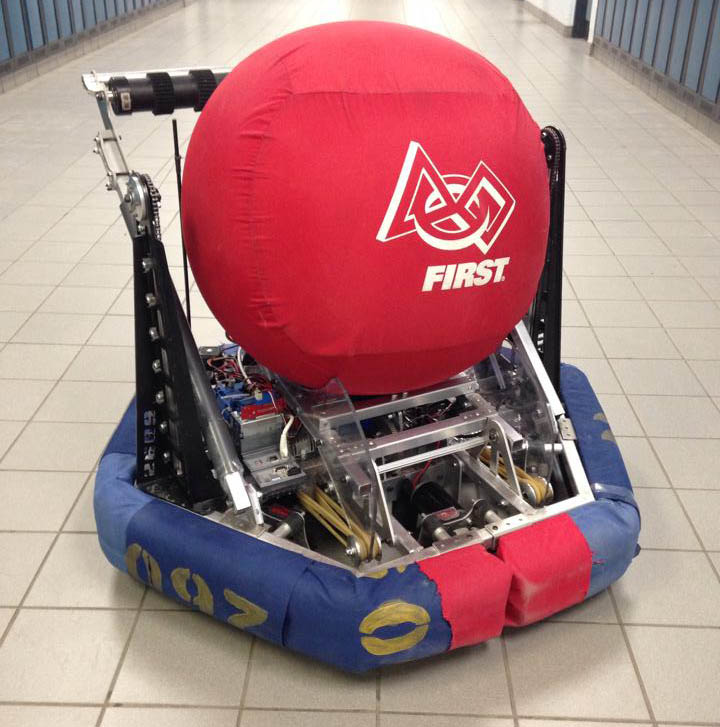
Third Place Winners
Team Name: Command Center
“Mobile Robotic Arm”
Group Members:
Mohammad Hasan, Tazook Bukhari
Description of Robot:
The robotic arm is mounted on a four wheel, all purpose, individually powered tires, high torque vehicle. The control station was built with the intention of supplying easy access and control. Therefore, be having a mobile control station enables convenient control of the robotic arm and vehicle. For the design of the robotic arm, we wanted to simulate a human arm by which we used several bearing to resemble human joints, the robotic grip to resemble a cuffed human hand. In convenience, the design behind the control system was to promote and stimulate natural human movements.
For the design of the robotic car, we wanted to ensure that the structure supported heavy weights picked up and still maintain a decent speed. Also, the body holds a camera that opts for a 120 degrees range in the horizontal and 90 degrees in the vertical live view.
Team Name: 4618- CN Robotics
Robot Function:
To compete in the First Robotics Competition
Group Members:
Martin Skot, Pavle Arinzina, Christian Davis, Steven Chupul, Philip Pateman
Description of Robot:
Team 4618’s robot Dusty was designed and built to play in the 2014 FIRST Robotics Competition game Arial Assist.
In order to compete, teams had to manufacture and compete with a robot that can pick up, pass and launch a large exercise ball several feet into the air. We accomplish this by using 2 large motors and a chain to rotate a catapult arm, resulting in an indefinite shot variation, for both short and long range. We intake balls through the back of the robot using 2 motors with locking transmissions to not hold the ball but secure it into place during high speed runs with the ball. The difficulty of the competition comes from the extremely strict robot rules found in the game manual, similar to auto racing and engineering projects there are tight rules regarding size, weight, motors, and electrical, and by adhering to these rules teams are still able to build thousands of unique robots.
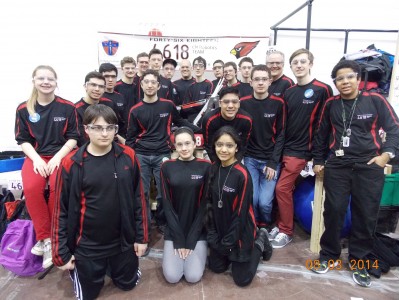
Team Name: ARMADA
Robot Function:
Autonomous, Intelligent and Cooperative Robot
Group Members:
Ian Berlot-Attwell
Description of Robot:
The robots are essentially small mobile computers with an array of sensors, communication and navigation hardware. Mobility is achieved with wheels or tracks for more rugged terrain. They operate in “swarm” mode; this is, cooperating with each other to achieve maximum efficiency. An added advantage of such a behavior is that the number of robots can be increased arbitrarily as required and therefore they can cover any surface size and adapt automatically to these new conditions. I called my robotic swarm “Armada” for Automated Robotic Monitoring and Detection Autobot. They can carry any type of available sensor (IR, radiation, chemical vapor, sound, etc.) and they know their location by either GPS or Inertial Guidance. They can be used from small areas (a house) to large areas (an airport or nuclear plant). They can perform safety or identification monitoring and either sound an alarm or communicate with a central system for reporting purposes. Their basic software is designed to cope with any surface configuration without the need for a map. They can transmit navigation information to other members, and hence automatically design a highly effective patrol pattern.
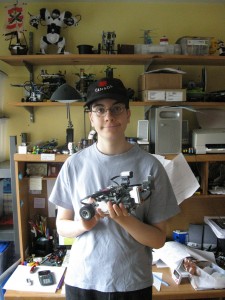
Team Name: BeaverworX
Robot Function:
Aerial Assist Competition Robot
Group Members:
Tom Vuong, Reli Desosa, Mayur Saxena, Billy Parmenter
Description of Robot:
The robot, Polar Vortex, is a competitive game playing robot designed for the 2014 FIRST competition. FIRST imposes limits on the size and shape of the robots. Polar Vortex is 44” in its greatest diameter and 42” tall. “AERIAL ASSIST is played by two competing Alliances of three robots each on a flat 25’ x 54’
foot field, straddled by a truss suspended just over five feet above the floor. The objective is to score as many balls in goals as possible during a two (2)-minute and 30-second match. The more Alliances score their ball in their goals, and the more they work together to do it, the more points their Alliance receives.” (US FIRST) To achieve this Polar Vortex is capable of a great deal of control of the ball. The ball can be retrieved from the ground or a teammate, ejected, or thrown at a variety of targets. Polar Vortex is also very capable of motion, being specifically designed for maneuverability. Ball pickup and ejection is achieved using a roller assembly at the end of an arm. The arm is placed over the ball and then pulls it onto a spring-loaded launcher in the centre of the robot. The arm and roller can eject the ball, or be moved out of the way to allow it to be launched.
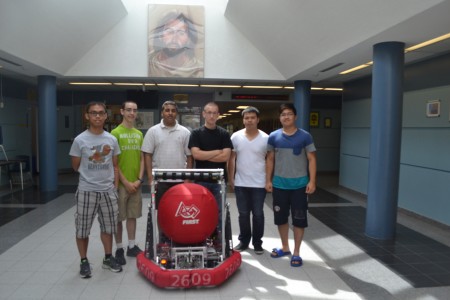
Team Name: Command Center
Robot Function:
Mobile Robotic Arm
Group Members:
Mohammad Hasan, Tazook Bukhari
Description of Robot:
The robotic arm is mounted on a four wheel, all purpose, individually powered tires, high torque vehicle. The control station was built with the intention of supplying easy access and control. Therefore, be having a mobile control station enables convenient control of the robotic arm and vehicle. For the design of the robotic arm, we wanted to simulate a human arm by which we used several bearing to resemble human joints, the robotic grip to resemble a cuffed human hand. In convenience, the design behind the control system was to promote and stimulate natural human movements. For the design of the robotic car, we wanted to ensure that the structure supported heavy weights picked up and still maintain a decent speed. Also, the body holds a camera that opts for a 120 degrees range in the horizontal and 90 degrees in the vertical live view.
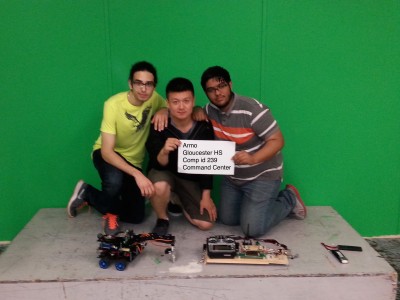
Team Name: GHGT
Robot Function:
Light Painting
Group Members:
Abdu Khodr, Ash Liu, Behzad Akbari, Colin Gagich, Dominik Kaukinen, Ethan D’Mello, Mbako Zubair, Michelle Wu, Vinay Yuvashankar, Wales Zhou, William Cameron, William Zhang, Ziyang Lu
Description of Robot:
The purpose of the robot designed by the GHGT Robotics Team is to produce a light painting that is based on a user’s input into a connected drawing application. The robot is constructed from a drone aircraft and utilizes a LED light source to produce the drawing and an Arduino controller coupled to a WiFi Shield to receive flight instructions. The user of the robot draws a picture using an application designed for a smartphone or tablet. This application converts the drawing into a grid of two-dimensional position coordinates and passes this information to a computer program. The computer program calculates the necessary flight path for the robot and communicates these instructions to the Arduino controller over WiFi. The robot completes this calculated flight path and the light painting is recorded by a long exposure camera. A secondary camera is also used to track the current position of the LED light source which allows for a live feedback system to be implemented into the flight calculation. This ensures that the robot’s flight path instructions are corrected against variations in the surrounding air flow conditions.
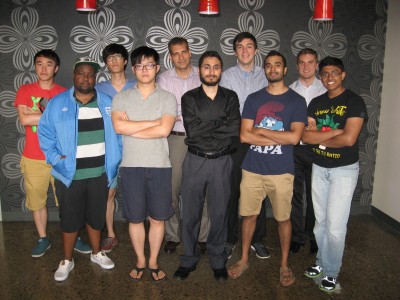
Team Name: Humberview Alpha Dogs
Robot Function:
Ball Manipulation
Group Members:
Brendon Fallon, Jeremy Sant, Alicia Matis, Cole Cyr, Stefan Pleava, Brian McCrindle, Matthew Reynolds, Harry Hautot
Description of Robot:
The 2014 FIRST Aerial Assist challenge involves the scoring of a 2 foot diameter exercise ball in both ground goals and 7 foot high goals. Our robot was built for this challenge and is able to move by itself and manipulate, through a cycle of control, the 2 foot diameter exercise ball in 3D space with a high degree of accuracy. The robot achieves this through 3 stages which are:
- In-taking the ball into the robot through a rotating shaft with wheels
- Holding the ball in a loading area while moving
- Out-taking the ball either by shooting through a wheeled shooter or through the rotating shaft
Through the use of a sensor, Alph is able to eject the ball through the wheeled shooter with variable rotational speed to change the height and distance of the shot. These speeds can be saved and key bound to the operations controller for repetitive distance shooting or varied manually by the operator. The robot is also able to traverse space and fire the ball autonomously with the use of a gyroscope and ultrasonic distance sensor, which can be used to move the robot to a specific distance from a wall. The robot is controlled through the use of two joystick controllers which allow for separation of movement and operation controls for ease of task execution. The controllers are hooked up to a driver’s laptop which connects to the robot via an onboard router.
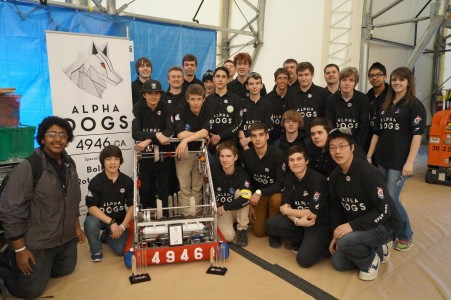
Team Name: Kinetic Knights
Robot Function:
Ball Collector and Launcher
Group Members:
Chris Pierce, Gregory Dadson, Mathew Strader, Bradley Reid, Nikhil Deshpande, Aaron Gordon, Jed Gonzales, Virat Trapathi
Description of Robot:
Our robot “Moose” has three main design features. The ball launching catapult, the fast and effective intake, and the powerful and robust drive train. The catapult is powered by two rear suspension springs of a snowmobile and retracted by a miniCIM motor and a linkage system that we call the “Choo-Choo”. The ball is cradled by two hockey stick blades. The intake consists of two rollers that stick out of the back of the robot to pick the ball up off of the ground. These rollers then push the ball into small fast spinning wheels which quickly put the ball into position and hold it there. The drive train is powered by a total of four CIM motors. It has two gears, a high and a low. The high gear allows the robot to go about 15 ft/sec and the low gear allows it to go about 5 ft/sec. The drive train has six 8in pneumatic wheels, this gives the robot maximum traction and pushing power. Our robot also has many sensors and various electronics to make it function well.
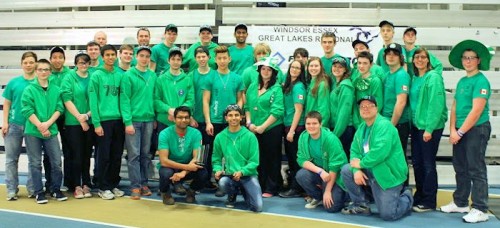
Team Name: Robotics for Space Exploration (RSX)
Robot Function:
Origin – Martian Exploration Rover
Group Members:
Karim Koreitem, Rahul Goel, Kramay Patel, Askar Kazbekov, Aakash Goel, Philip Lee, Masha Itkina, Kiah Bransch, He He, Bryan Tarras, Kevin Olsen, Ekansh Sharma
Description of Robot:
Origin is a tele-operated rover designed for planetary exploration – specifically, Mars. It is controlled from a distant base station, and is equipped with various mechanical components, sensors, and electronics. It is designed to rove and complete a variety of tasks in challenging environments where human involvement is unsafe or impossible. 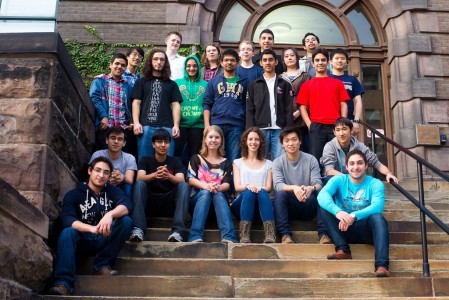
First Place Winners
Team: JUNRU (Jerry) Chen
School: Central Secondary School, London, ON
Robot: Automatic Irrigation Unit – Robotic Watering System (RSW)
Description of Robot:
The RWS consists of a commercially available hose and watering apparatus, the latter attached to digital servos allowing multidirectional movement. The servos are attached to a water and dust-proof case, held up by a tripod stand. Also attached to the case is a pressure sensor. Inside of a RWS is an arm-based microcontroller, which provides serial communication interfaces, allowing the RWS to communicate with sensors, the two digital servos and a human machine interface (HMI).
- The RWS employs an android-based HMI. On the HMI is a graphic user interface which allows the user to “see” and interpret data with increased facility and perform other functions such as uploading or downloading watering data and setting up watering schedules.
- The function of the RWS is to water any user-defined shape, and the purpose of the design is allowing this function while enhancing portability, autonomy, and flexibly.
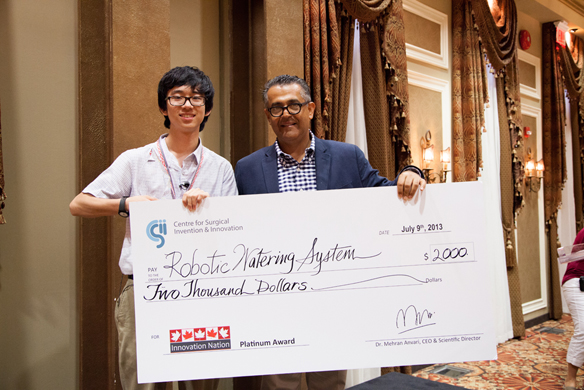
Second Place Winners
Team: Red Devils
School: Oakville Trafalgar High School, Oakville, ON
Robot: Disc Shooting, Tower Climibing, 6 Wheel Drive Tank
Description of Robot:
Our robot, Jebidiah, was designed to play the 2013 FIRST Robotic Competition game – Ultimate Ascent. Competing teams are put into alliances of three teams, and two alliances compete in each match. Robots need to shoot Frisbees and climb a tower to score points. Strategy is a very important aspect of our robot design because there are multiple ways a team can maximize their success in playing the game. One element of strategy is deciding the height to climb on the pyramid. You need not climb all the way to the third level; however, you maximize your scoring potential if you do. We chose to climb to the top because it would be a unique and challenging feature of our robot in the competition. We chose to climb on the outside corner of the pyramid because if other robots on our alliance wished to climb, there would be space at the top for all. For out shooter we decided to develop on arch style shooter, because on arch shooter maintains constant contact with the Frisbee ensuring consistent shots. Another challenge we faced was adhering to the FIRST game manual which outlines strict rules in terms of robot size, weight and number of components (motors, pneumatics, etc.) a team may use. All of the robots’ mechanisms must fit within the chassis frame perimeter of 112”. Our vision of expanded functions for Jebidiah includes aiding firefighters and rescue workers in delivering fire suppressants and supplies through the use of our shooter, climber and dumper
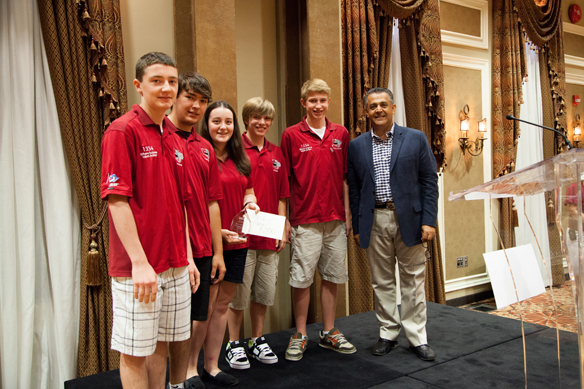
Third Place Winners
Team: Robot Heads
School: St Ignatius of Loyola Catholic Secondary School, Oakville, ON
Robot: Automatic Cereal Dispenser
Description of Robot:
The Automatic Cereal Dispenser is a robot designed to deliver a bowl of cereal filled with one spoon, cereal and a liquid. It can do so on demand or on a schedule. It is composed of six sub-systems:
1. Primary Structure: Cereal dispensing and weighing; cereal transport within the system and air pressure generation
2. Electric and Electronic Components: Programmable Controllers, Sensors, and Motors
3. Liquid Delivery: Fridge Assembly, Temperature Monitoring and Piping
4. Software: Control Programs
5. Calibration Procedures: Weight, Liquid and
Temperature
6. Table Transport: Cereal Bowl transport on table (remote controlled)
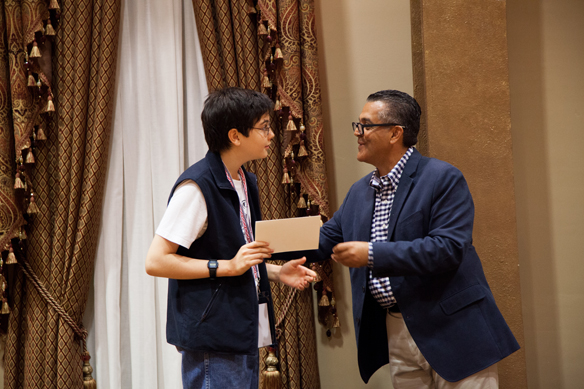
Fourth Place Winners
Team: Parguzat Kahar
School: Gloucester High School, Ottawa, ON
Robot: Command Centre – Scouting, Spying and UAV Launching
Description of Robot:
The robot features:
- 4 wheels driving system. The function of the design is to allow smooth and balanced trips.
- Camera with infrared light for night mode. Allows people to drive at night.
- Robotic arm (RAI) to pick up items. Allows easy control as well as human’s arm.
- UAV/Rocket Launcher. Allows the user to launch the UAV from the robot by the remote control and the UAV can also send the real time video feedback to the ground control station.
